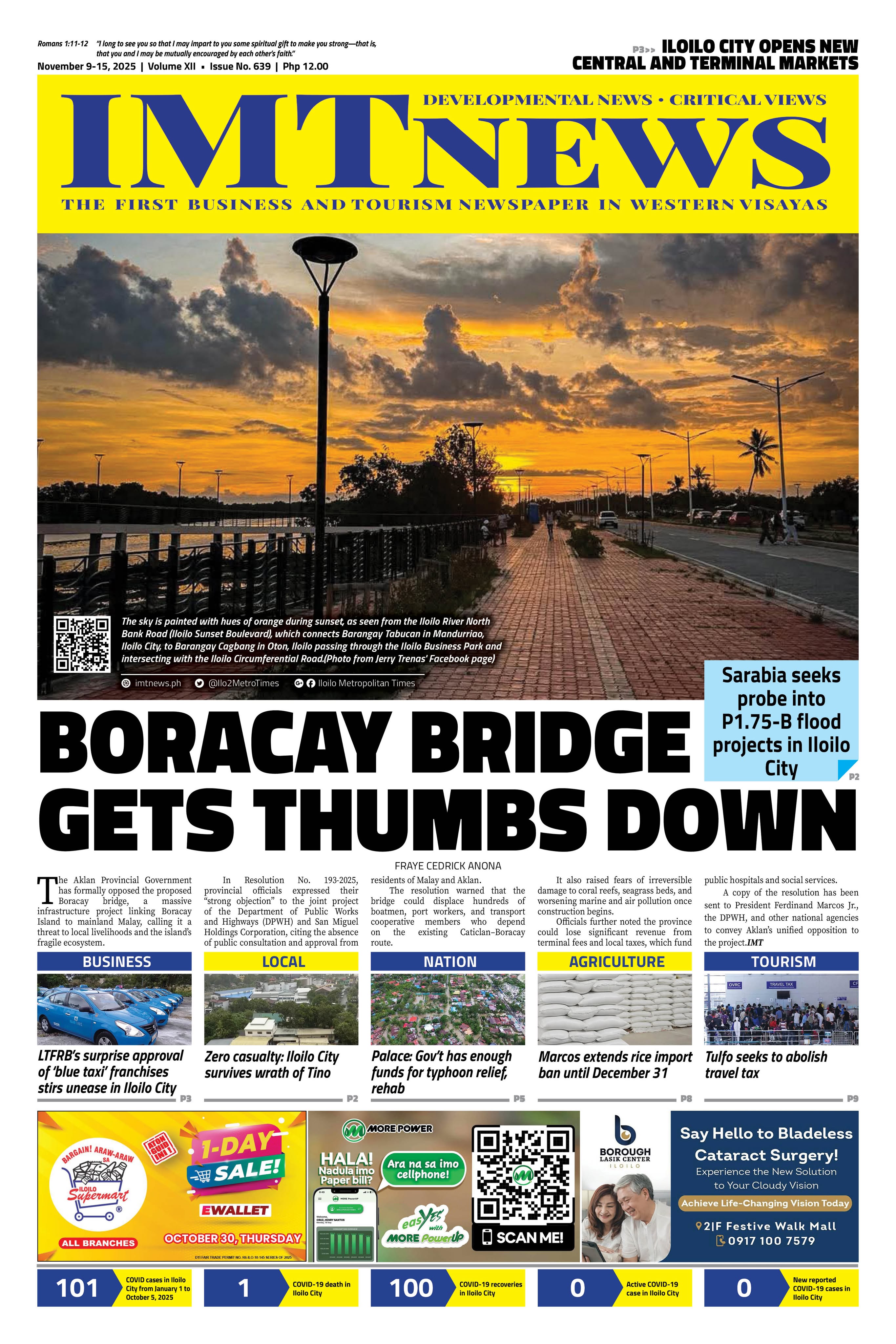There are cities that drown with every headline, and there are cities that rise quietly with every storm. Iloilo, in part, belongs to the latter, but let me qualify it. When Typhoon Tino battered the Visayas this November, leaving Cebu and nearby provinces submerged and their floodwalls crumbling, Ilonggos mostly and relatively stayed dry. No frantic rescue boats, no wading through Diversion Road—just drizzle, drainage, and calm. It was not luck. It was the fruit of something rare in public works: a project that worked, stayed honest, and remembered why it was built.
The Jaro Floodway, completed in 2011 through the partnership of the Japan International Cooperation Agency (JICA), DPWH, NHA, and the Iloilo City Government, stands as living proof that infrastructure can outlast politics. Born not just from the devastation of Typhoon Frank in 2008 but also from decades of absence—a city with no real flood control backbone—it finally gave Iloilo a fighting chance. Before that, floods were annual visitors, especially in the flatlands of Jaro and La Paz. The floodway changed that. It redirected the fury of the Tigum and Aganan Rivers straight to the sea, sparing the city’s heart. When economists once dismissed it for “low return on investment,” leaders headed by Senator Frank Drilon fought back, insisting that the return was measured in lives, not pesos.
JICA’s 2016 evaluation affirmed what every Ilonggo could see: since its completion, Iloilo City has not experienced a catastrophe on the scale of Frank. While Cebu and other provinces suffered devastating floods after Typhoon Tino—despite billions poured into “flood control”—Iloilo City remained safe, relatively speaking. That contrast speaks volumes. The Jaro floodway was built with science, sincerity, and supervision. It is five kilometers of quiet success—a channel that listens to nature instead of fighting it.
Across the country, however, the picture looks different. Typhoon Tino revealed what happens when projects are designed for profit, not people. A ₱55-million “completed” flood structure in Bulacan existed only on paper. In San Miguel, Iloilo, a ₱96-million embankment collapsed before the rains even started. In Arevalo, transparency boards went missing, and contractors’ names switched like election slogans. Some of these projects are linked to one family’s companies, now under national scrutiny. As one barangay captain sighed, “We only see cement when the water rises.”
That is what makes the Jaro Floodway’s story almost mythical. Its secret was humility and wisdom—a willingness to learn from the river rather than control it. Engineers shaped bends, planted mangroves, and let gravity do what pumps could not. It was engineering that respected ecology. That same mindset flowed into the Iloilo River Esplanade—a ten-kilometer green spine that doubles as a flood buffer and public park. What began as a dike became a way of life, blending protection and recreation.
Teachers passing by the Esplanade often point it out to students as a living lesson: governance is not about grand speeches or plaques; it is about keeping families safe. Studies by the UP Resilience Institute (2023) show that when local governments listen and collaborate, disaster losses drop by nearly half. The Jaro Floodway embodied that long before “resilience” became fashionable. It was a project built not just by contractors but by a community that refused to drown again.
Yet complacency is dangerous. The Jaro Floodway protects us from the north, but many low-lying areas in Lapuz, La Paz, and City Proper, even a big part of Jaro, still depend on outdated drainage and makeshift canals. The sinking Iloilo City remains without a comprehensive flood control master plan. The floodway may be our shield in the outskirts of the metropolis, but it cannot stand alone. One strong storm—one path like Tino’s over Cebu, like Sendong over Cagayan de Oro, or like Yolanda’s over northern Iloilo—could expose the gaps we have ignored. As Typhoon Uwan looms, this is the moment to prepare, not to assume that yesterday’s defenses will save us tomorrow.
In recent years, new DPWH projects have appeared along creeks and tributaries—some oversized, others misplaced. Many warned that these uncoordinated structures have worsened flooding in over ninety barangays in Iloilo City alone. One ₱49-million “flood-control with bike lane” project in Tagbak nearly sealed a creek, and during Tropical Storm Dante, a child drowned there. When flood control turns into flood creation, negligence becomes a sin.
The ongoing scandal surrounding ₱350 billion worth of ghost projects nationwide proves that corruption is the country’s deadliest deluge. The Senate’s Blue Ribbon Committee uncovered how some contractors, ironically named after saints, bid against themselves to corner projects. The Independent Commission for Infrastructure called it one of the gravest public-works scandals in decades. Climate change may bring stronger storms, but it is greed that keeps us underwater. As Pope Francis wrote in Laudato Si’, this crisis is not merely environmental but moral—a sickness of the heart that forgets who pays when systems fail.
Still, the river teaches. The Jaro Floodway endures because it was built with conscience and cooperation. It reminds us that real leadership channels energy toward the common good, not political credit. It clears paths, not pockets. It is what educators call modeling—leading quietly but effectively. The Esplanade, its younger sibling, proves that infrastructure can heal rather than harden a city. It turned concrete into community, and a once-flooded delta into one of the Philippines’ most livable spaces.
Now, as Typhoon Uwan approaches, we find ourselves at a crossroads. The Jaro floodway may have saved us before, but it is not a guarantee. Iloilo must plan beyond its pride. It needs a comprehensive master plan that unites its rivers, creeks, estuaries, wetlands, low-lying basins, coastlines, drainage systems, road networks, sewage systems, ports, wharves, bridges, and dikes into one resilient system—a plan that ensures no barangay is left to wade alone. The lesson is clear: honest work protects lives; delayed planning endangers them.
Integrity is not loud, but it lasts. The Jaro Floodway’s quiet strength continues to guard the city, reminding us that good engineering begins with empathy, not cement. May we learn from the river that chose to work—and may we choose to do the same, before the next storm decides for us.
Doc H fondly describes himself as a “student of and for life” who, like many others, aspires to a life-giving and why-driven world grounded in social justice and the pursuit of happiness. His views do not necessarily reflect those of the institutions he is employed or connected with.







